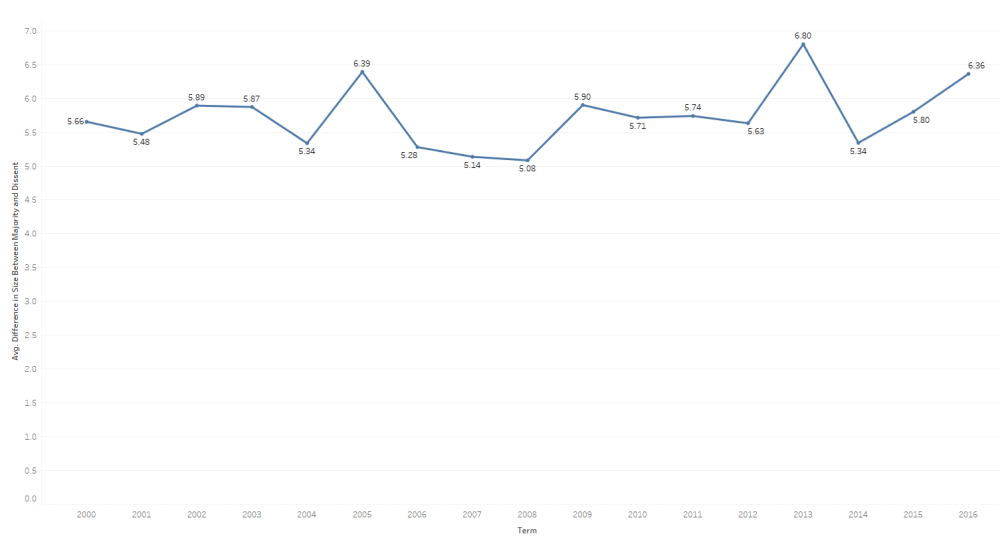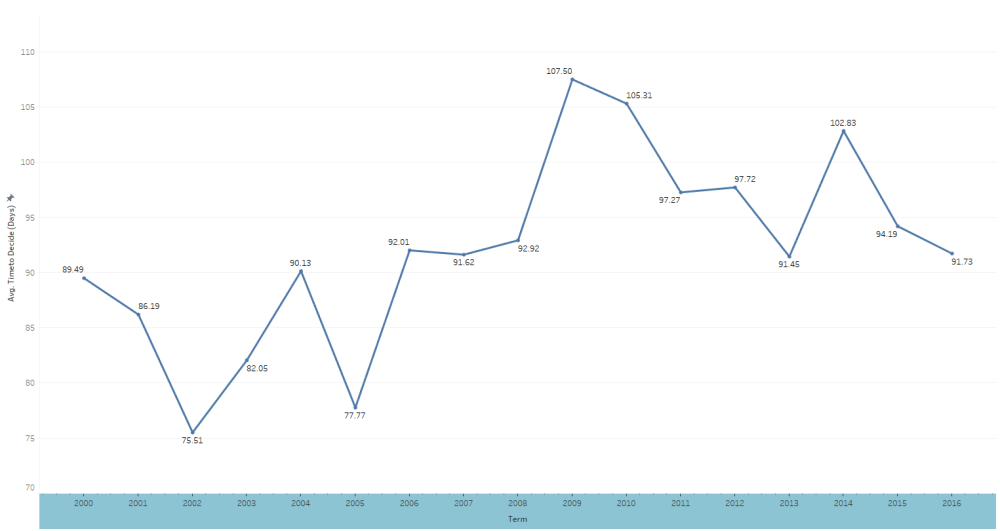It has been almost two months since the completion of the Supreme Court’s 2016 term. Scholars and analysts have pored over Court’s decisions. SCOTUSBlog released its Stat Pack which contains many interesting statistical trends and details from the term. Each term, a group of professors now organized through the Washington University in St. Louis School of Law put together a new iteration of the Supreme Court Database which contains even more detailed coding on each case and which scales the measures so that trends can be tracked over multiple terms. These data often lead to the discovery of new information about the term that was not easy to perceive without the longitudinal organization of a term’s data along with those from prior terms.
This post utilizes some of these newly released data to uncover three unique aspects of the Court from this past term. The first is the size of the Court’s majority across different types of cases. The second is the length of time between oral argument and when the Court issued its opinions. Lastly are differences in the justices’ voting relationships with one another.
Majority Size
The size of the Court’s majority in a given case is an indication of the justices’ cohesion regarding the Court’s decision (it is also recognized by some as a potential sign of the legitimacy of the Courts’ decisions). This works in two directions. On one hand justices that write opinions that appeal to a greater number of justices should have larger majority coalitions. On the other hand justices writing opinions in cases where there is little consensus among the justices will have a harder time putting together large majorities. With these two forces in mind we can first look to the average difference in size between the Court’s majority and dissenting coalitions between the 2000 and 2016 Supreme Court terms.
2016 is one of only three terms since 2000 with an average majority size of at least six justices more than the average dissent size. With an eight member Court as the Court had for the most of the term, this means that majority sizes averaged more than seven justices to a dissent average of one justice. For the April session cases which included Justice Gorsuch’s votes, the average coalition size could dip a bit but only minutely to maintain the average differential in coalition size.
Perhaps more interesting over the past several terms is the average differential size of the majority versus dissenting coalitions depending on the majority author.
This term, for instance, Justice Alito wrote opinions with the largest average difference in size followed by Justices Sotomayor and Kagan (Justice Gorsuch actually had the largest differential with his single unanimous opinion in Henson v. Santander). The implication here is that these Justices had a combination of less contentious cases and wrote opinions that appealed to a larger number of justices.
This term Justice Roberts had the fourth highest average difference in coalition size at just under 6.5 votes. Last term Justice Roberts had the second largest vote difference after Justice Scalia. Justice Kagan had the largest transition in size between terms as she had the lowest voter differential last term. It should come as no surprise that Justices Kennedy and Breyer vied for the smallest voter differential over the past several terms as they often play the role of swing justice in close cases and therefore write some of the more contentious majority opinions. In 2016 Justice Breyer had the lowest differential by an appreciable margin under Justice Kennedy.
Time to Decide
The Justices hear their first oral arguments each term in October and end their terms in June. Over this nine month period they write opinions in all decided cases with many opinions coming after all oral arguments are completed in April. This term the justices’ average time between oral argument and opinion was on par with many other Roberts Court years.
With an average of 91.73 days between oral argument and opinion release, the justices moved quickest this term than they did in the past two. This amount of time, however, was considerably more than it took the Court to write opinions during Chief Justice Roberts first year on the Court in 2005 when it took the justices an average of 77.77 days between oral arguments and opinions.
As with the differential sizes of the majority and dissenting coalitions, the amount of time it takes the justices to write opinions also relates to the contentiousness of cases, the ease with which the majority opinion is assigned, and relatedly, the difficulty in obtaining and maintaining a majority coalition.
When viewing the justices individual statistics, the amount of time to reach decisions does not appear as related to the contentiousness of decisions as does the differential in coalition size.
Justice Kagan has taken the longest time between oral argument and opinions over the past two terms. The length and complexity of Justice Kagan’s opinions likely contribute to this time lag as she wrote the longest decision this term with Cooper v. Harris.
On the opposite end of the spectrum, Justice Sotomayor took the least time (aside from Justice Gorsuch) to write her majority opinions this term and has been between the middle and the bottom of the pile over the past several terms. Justice Breyer took the second longest average time to write opinions this term followed by Justices Thomas and Kennedy. Even with his contentious opinions, Justice Kennedy has not taken the longest time between oral argument and written opinions since the 2012 term.
A Few Points on the Justices’ Unique Relationships in 2016
- This was the first full term where neither Justice Kagan nor Justice Ginsburg dissented from any of Justice Alito’s majority opinions.
- 2016 was the first term since 2010 when Justice Sotomayor had only one dissent from a majority opinion Justice Alito authored. This term Justice Sotomayor dissented in Bristol-Myers Squib v. Superior Court and in 2010 she dissented in United States v. Jicarilla Apache Nation.
- This was the first term since 2011 where Justice Ginsburg had more than one dissent from Justice Breyer’s opinions. In 2016 she dissented in Turner v. United States and Midland Funding v. Johnson.
- This term also marked the term where Justice Kagan dissented from the most majority opinions authored by Justice Breyer with two. She dissented in the same cases as Justice Ginsburg (listed above).
- Justice Sotomayor was the only justice (aside from Gorsuch) with one or fewer dissents from Justice Kennedy’s majority opinions this term. Her dissent was in CalPERS v. ANZ Securities.
- This was the first term since 2013 where Justice Alito did not dissent from one of Justice Sotomayor’s opinions.
- Justice Thomas also did not dissent from any of Justice Sotomayor’s opinions for the first time since the 2011 term.
On Twitter: @AdamSFeldman




7 Comments Add yours